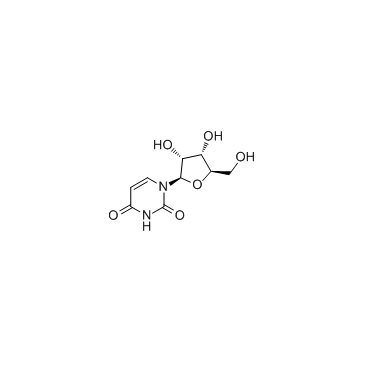Uridine

Uridine structure
|
Common Name | Uridine | ||
|---|---|---|---|---|
| CAS Number | 58-96-8 | Molecular Weight | 244.201 | |
| Density | 1.9±0.1 g/cm3 | Boiling Point | 567.9±60.0 °C at 760 mmHg | |
| Molecular Formula | C9H12N2O6 | Melting Point | 163-167 °C(lit.) | |
| MSDS | Chinese USA | Flash Point | 297.2±32.9 °C | |
|
Polyoxometalates--potent and selective ecto-nucleotidase inhibitors.
Biochem. Pharmacol. 93(2) , 171-81, (2015) Polyoxometalates (POMs) are inorganic cluster metal complexes that possess versatile biological activities, including antibacterial, anticancer, antidiabetic, and antiviral effects. Their mechanisms of action at the molecular level are largely unknown. Howeve... |
|
|
Lipocalin 2 modulates the cellular response to amyloid beta.
Cell Death Differ. 21(10) , 1588-99, (2014) The production, accumulation and aggregation of amyloid beta (Aβ) peptides in Alzheimer's disease (AD) are influenced by different modulators. Among these are iron and iron-related proteins, given their ability to modulate the expression of the amyloid precur... |
|
|
BAG3 Promoted Starvation-Induced Apoptosis of Thyroid Cancer Cells via Attenuation of Autophagy.
J. Clin. Endocrinol. Metab. 99(11) , E2298-307, (2014) BAG3 plays a regulatory role in a number of cellular processes. Recent studies have attracted much attention on its role in activation of selective autophagy. In addition, we have very recently reported that BAG3 is implicated in a BECN1-independent autophagy... |
|
|
Characterization, antioxidative and ACE inhibitory properties of hydrolysates obtained from thornback ray (Raja clavata) muscle.
J. Proteomics 128 , 458-68, (2015) Thornback ray muscle hydrolysates (TRMHs) prepared by treatment with proteases from Bacillus subtilis A26 (TRMH-A26), Raja clavata crude alkaline protease extract (TRMH-Crude), Alcalase (TRMH-Alcalase) and Neutrase (TRMH-Neutrase) were elaborated and their an... |
|
|
Altered age-related changes in bioenergetic properties and mitochondrial morphology in fibroblasts from sporadic amyotrophic lateral sclerosis patients.
Neurobiol. Aging 36 , 2893-903, (2015) Mitochondria play a key role in aging, which is a well-established risk factor in amyotrophic lateral sclerosis (ALS). We have previously modeled metabolic dysregulation in ALS using fibroblasts isolated from sporadic ALS (SALS) and familial ALS patients. In ... |
|
|
Targeting Mitochondria with Avocatin B Induces Selective Leukemia Cell Death.
Cancer Res. 75 , 2478-88, (2015) Treatment regimens for acute myeloid leukemia (AML) continue to offer weak clinical outcomes. Through a high-throughput cell-based screen, we identified avocatin B, a lipid derived from avocado fruit, as a novel compound with cytotoxic activity in AML. Avocat... |
|
|
Low abundance of mitochondrial DNA changes mitochondrial status and renders cells resistant to serum starvation and sodium nitroprusside insult.
Cell Biol. Int. 39 , 865-72, (2015) Mutation or depletion of mitochondrial DNA (mtDNA) can cause severe mitochondrial malfunction, originating from the mitochondrion itself, or from the crosstalk between nuclei and mitochondria. However, the changes that would occur if the amount of mtDNA is di... |
|
|
Transfer of mitochondria via tunneling nanotubes rescues apoptotic PC12 cells.
Cell Death Differ. 22 , 1181-91, (2015) Tunneling nanotubes (TNTs) are F-actin-based membrane tubes that form between cells in culture and in tissues. They mediate intercellular communication ranging from electrical signalling to the transfer of organelles. Here, we studied the role of TNTs in the ... |
|
|
Mitochondrial (dys)function - a factor underlying the variability of efavirenz-induced hepatotoxicity?
Br. J. Pharmacol. 172(7) , 1713-27, (2015) The non-nucleoside analogue reverse transcriptase inhibitor efavirenz is associated with hepatic toxicity and metabolic disturbances. Although the mechanisms involved are not clear, recent evidence has pinpointed a specific mitochondrial action of efavirenz a... |
|
|
Increased Histone Deacetylase Activity Involved in the Suppressed Invasion of Cancer Cells Survived from ALA-Mediated Photodynamic Treatment.
Int. J. Mol. Sci. 16 , 23994-4010, (2015) Previously, we have found that cancer cells survived from 5-Aminolevulinic acid-mediated photodynamic therapy (ALA-PDT) have abnormal mitochondrial function and suppressed cellular invasiveness. Here we report that both the mRNA expression level and enzymatic... |